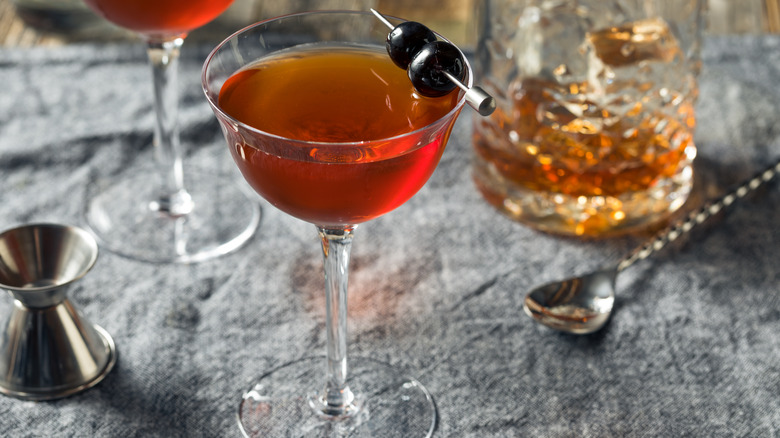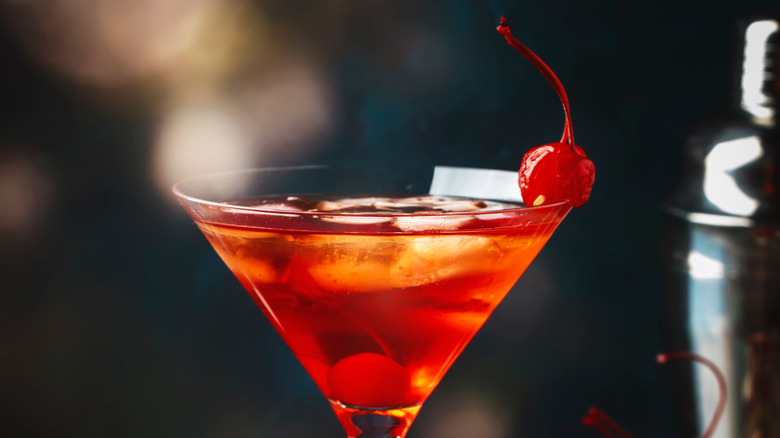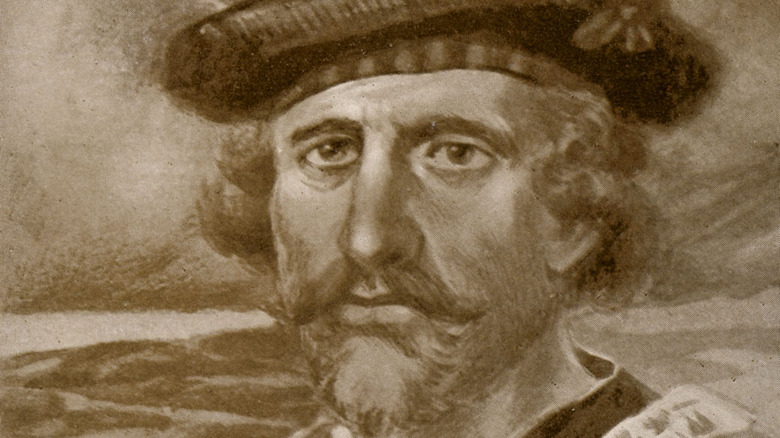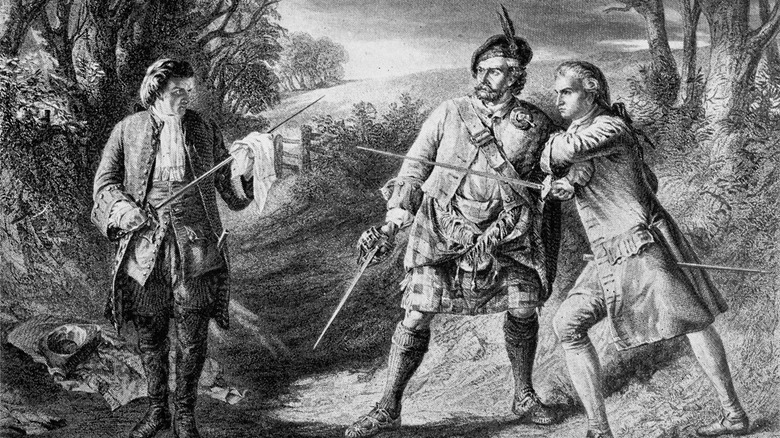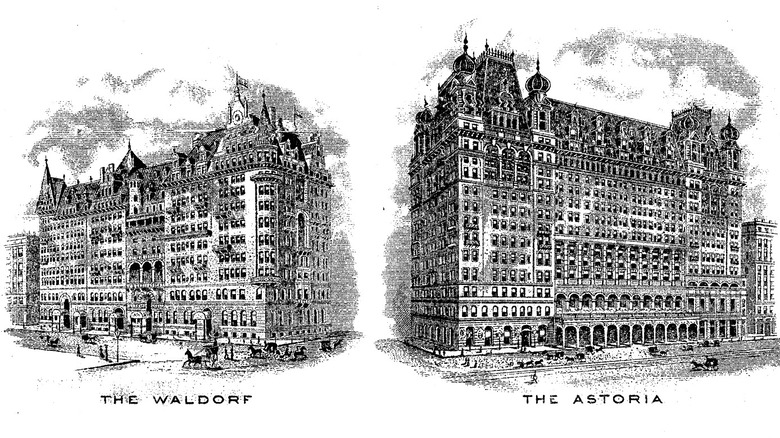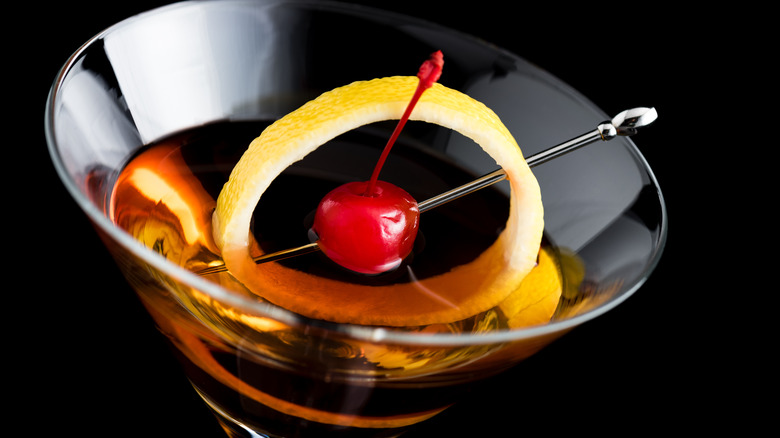The History Of How The Classic Rob Roy Cocktail Got Its Name
Whiskey cocktails are an all-American innovation. Per Drink magazine, in Europe it's traditional to drink the spirit straight or with a small amount of water. In the United States, pharmacists began mixing carbonated and alcoholic drinks for medicinal purposes; eventually, people began drinking the concoctions for pleasure rather than health, and saloons, taverns, and bars manned by bartenders became the place to consume them.
The first American book of cocktail recipes was published in 1862 by New York bartender Jerry Thomas, as reported by The New York Times, and the United States went on to be known worldwide for its cocktail culture. Drink magazine pointed out that blended whiskey is already sort of a cocktail in and of itself, meant to not only economize but to blend the flavors of different types of spirits — smokey, peaty, floral, and so on. It can be challenging to take an already mixed liquor and combine it further into a well-balanced, tasty cocktail.
It all started with the Manhattan
The predecessor to the Rob Roy cocktail was the Manhattan cocktail (shown above). The Manhattan is generally thought to date back to the early 1880s and, per Taste Cocktails magazine, the popular origin story is its invention by Dr. Iain Marshall at a party held at the Manhattan Club in New York in honor of Lady Randolph Churchill, mother of eventual British Prime Minister Winston Churchill. The fact that this story has been debunked due to Lady Churchill being home in England and pregnant with Winston at the time doesn't make it any less popular.
Another theory, discussed on the Spirit of York website, came from the 1923 "Valentine's Manual of New York," which mentioned that William F. Mulhall, bartender at New York's Hoffman House, had told a story in which the Manhattan was invented by a man named Black who made cocktails at a bar "10 doors below Houston Street on Broadway."
The real Rob Roy was a sort of Scottish Robin Hood
Regardless of its birthplace, per Spirit of York's website, the first known Manhattan mention appeared in 1882 in New York's Sunday Morning Herald, and the first published recipe appeared in the 1884's "The Modern Bartenders' Guide" by O.H. Byron, which contained two versions, both featuring whiskey, vermouth, and bitters. Eventually, it became customary to use Canadian whiskey and garnish with maraschino cherries.
The Rob Roy cocktail came on the scene a decade later in 1894. Per Drink magazine, the 1890s saw an uptick for Americans' demand for Scotch whiskey after a keg of Dewar's was delivered to the White House in 1891. Three years later, an opera opened in New York based on the life of Scottish soldier and folk hero Robert MacGregor (shown above), also known as Rob Roy. As reported by Esquire, the real Rob Roy MacGregor was born in 1671 and was known as a sort of Scottish Robin Hood, described as a "rebellion leader, cattle thief, outlaw, and bandit."
From the Broadway stage to the cocktail menu
Per Esquire, the story of Rob Roy MacGregor (shown above, center) inspired several works about his life, including the 1817 historical novel "Rob Roy" by Sir Walter Scott, the poem "Rob Roy's Grave" by William Wordsworth, and the operetta "Rob Roy" by composer Henry Louis Reginald De Koven (who had previously written another operetta about Robin Hood) and lyricist Harry B. Smith. "Rob Roy" premiered on Broadway in 1894. A review in The New York Times called it "clean, frank, manly, bright, and winsome" and noted that the creators had "a considerable acquaintance with what is known as the smart set."
It makes sense that a cocktail bar would want to name a drink after a local trendy show, and this custom was in fact common in the 1890s. As reported by the Barina Craft blog, other cocktails inspired by Broadway shows and actors included the Adonis, after the 1884 play that was the first on Broadway to have over 500 performers, and the Fedora, after the 1882 play that also inspired the hat five years later.
Who mixed the first Rob Roy?
Which bartender is thought to have made the first Rob Roy cocktail? Like most cocktails' histories, there are lots of origin stories and no one's really sure which one is real. According to Vinepair, the first Rob Roy was created in the early 1870s by famous mixologist E.F. Barry, who made it with brandy, Angostura bitters, and orgeat. The version with Scotch whiskey has been credited to the bar at the Waldorf-Astoria (shown above), which at the time was right about the corner from the Herald Street Theater, as well as the Fifth Avenue Hotel bar, which was located down by Madison Square.
Still another Rob Roy tale says it came to be one night at the Duke's House bar across the river from Manhattan in Hoboken, New Jersey, when bartender Henry A. Orphal made a Manhattan with Scotch when a Scotch whiskey salesman wanted to drink one but didn't want a drink that excluded his wares. His solution was to replace the standard whiskey with Scotch and mix it with the usual sweet vermouth and bitters.
A classic cocktail standing the test of time
The Rob Roy's reputation as an upscale, sophisticated, slightly old-fashioned cocktail is part of its allure. The Perfect Potions blog traced decades of Rob Roy references in movies and television, starting with the 1940 film "Angels Over Broadway" in which Douglas Fairbanks Jr. and Rita Hayworth drink Rob Roys throughout at the Pigeon Club. In the 1999 movie "Blast From The Past," a teenager who was raised in a bomb shelter has watched his parents drink Rob Roys throughout his life and orders one at a bar, telling his date, "This is a popular drink, I'm told." In a 2004 episode of the show "Venture Brothers," the middle-aged Dr. Venture orders a Rob Roy at a bar and the bartender has to look up how to make one.
In 2010, writer David Wondrich lauded the Rob Roy for Esquire magazine, noting that it's a reliable favorite that's hard to mess up. Wondrich recommended it as a good cocktail option when "drinking in a place that was open for business when your grandfather was barely legal," calling it a better option than its parent drink, the Manhattan. The classic simplicity of the Rob Roy means its popularity has ebbed and flowed over time, but it's proved to have the kind of staying power that's kept it on cocktail menus for over a century.
